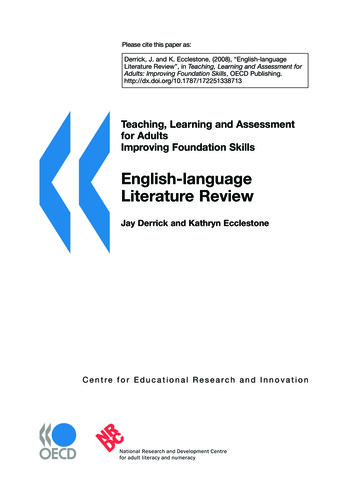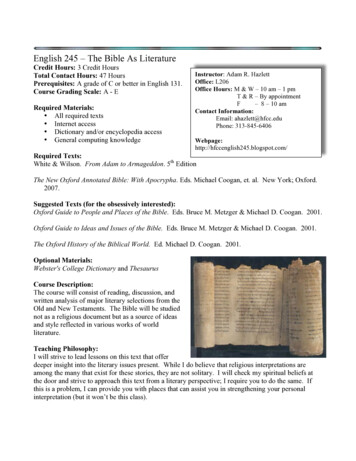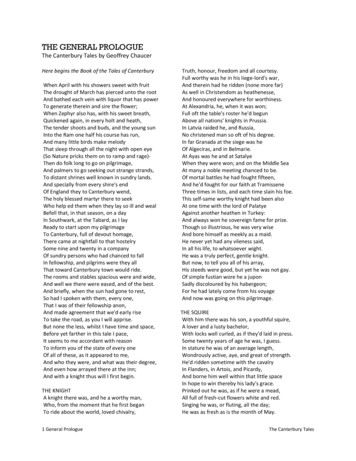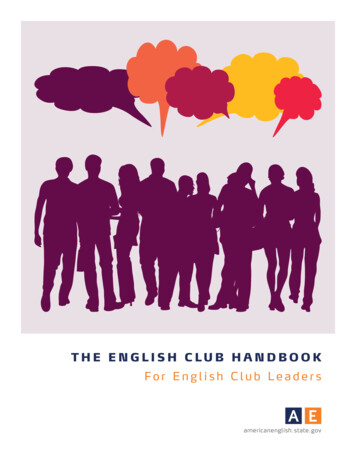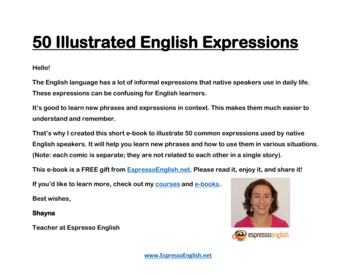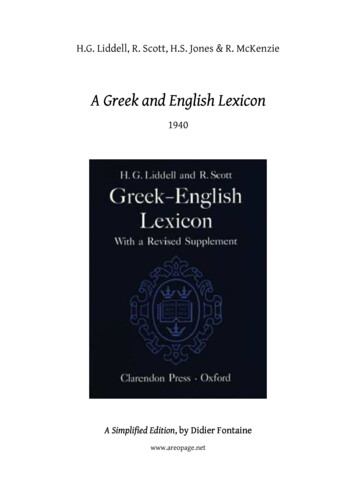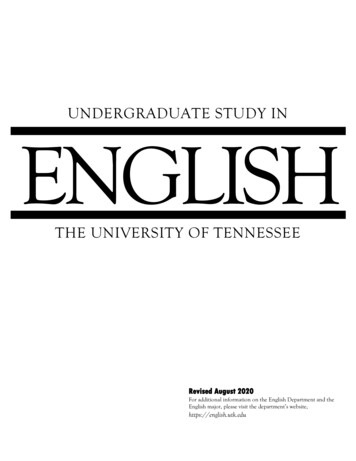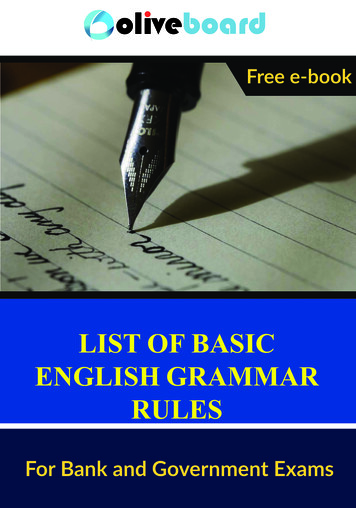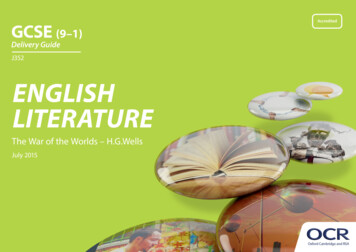
Transcription
GCSE (9–1)Delivery GuideJ352ENGLISHLITERATUREThe War of the Worlds – H.G.WellsJuly 2015
We will inform centres about any changes to the specification. We will alsopublish changes on our website. The latest version of our specification willalways be the one on our website (www.ocr.org.uk) and this may differ fromprinted versions.Copyright 2015 OCR. All rights reserved.CopyrightOCR retains the copyright on all its publications, including the specifications.However, registered centres for OCR are permitted to copy material from thisspecification booklet for their own internal use.Oxford Cambridge and RSA Examinations is a Company Limited by Guarantee.Registered in England. Registered company number 3484466.Registered office: 1 Hills RoadCambridgeCB1 2EUOCR is an exempt charity.
GCSE (9–1)ENGLISH LITERATURECONTENTSIntroduction Page 4Summary Page 6Characters Page 9Themes Page 11The Martians Page 13Assessment preparation Page 153
IntroductionHistorical and cultural contextfactual historical knowledge to the minimum required for fullunderstanding of the text and try to integrate it fully through thestudy of each chapter of the novel. Remember:In 1898 the British Empire was the most dominant colonialpower on earth. London was its political centre, making it anatural starting point for an imagined alien invasion.Towards the end of the 19th century a very real feardeveloped that the turn of the century would be the ‘end ofthe age’ and the apocalypse would begin. There was also afear of mass immigration due to colonialism.HG Wells used his own experiences in the novel and exploredfear of the unknown, paranoia and the possibility of the worldending. He also used the novel to explore his own misgivingsabout imperialism and explore how easily civilisation canbreak down when facedwith a seemingly unbeatableadversary. Quality of contextual understanding rather than coverage isimportant Focus and relevance of contextual comment are key – anycomments should be relevant to the text and/or the task Context applies to the genre, historical setting, and social/cultural perspectives.Other works by HG WellsThe Time Machine – through time travel Wells exploresgrowing class divisions and human greed.The Invisible Man – Wells explores actions and consequences,centred around one man’s descent into brutality, exposingthe power of science to corrupt.It is important that students areable to link their knowledge ofthe historical and cultural contextof the novel with the eventsdescribed. In written responsesstudents should integratecontextual understandingthroughout, rather than boltingon taught material. KeepThe Island of Doctor Moreau – Wells explores the dangersassociated with scientific progress, when Man begins to actas God.4
IntroductionSettingStructureMuch of The War of the Worlds is set in Woking and the nearbysuburbs, where HG Wells lived with his second wife, CatherineRobbins. The landing site of the first cylinder in the novel,Horsell Common, was within easy walking distance of theWells’ home.The story is narrated in hindsight about events that occurredsix years previously. The events of the novel span about amonth.The plot mostly follows in chronological order what happensbetween the landing of the first cylinder on Horsell Commonand the Narrator’s return home after the death of theMartians. Occasionally the narrative is interrupted to includescientific details learned later which are inserted throughoutthe book.One of the features of the novel is the small geographical area– the Narrator takes his wife to Leatherhead to protect herfrom the Martians, then makes his way through a number ofsmall towns including Weybridge and Shepperton.As the novel progresses, the destruction of the settings andenvironment is apparent with destroyed buildings, dead anddying people in the streets, black dust and red weed coveringeverything.The Narrator tells the story of his brother and his experienceswhen escaping from London.What happens to the Narrator is the main focus of the storyand the chapters are broken up by significant events of his lifeduring the time of the war.Key settings:Horsell Common: the site of the first cylinder landing.The novel is split into two books: Book 1 – The Coming of theMartians, and Book 2 – The Earth Under the Martians. Eachchapter has a title, which is useful to discusss fully to analyseits significance.Leatherhead: home of the Narrator’s cousin, seen as a place ofsafety.Shepperton: the scene of a Martian attack.Sheen: where the fifth cylinder lands and buries the Narratorand the Curate.Putney Hill: where the Narrator meets the Artillary Man.London: the Narrator’s brother recounts the flight from thecity.5
SummaryBook 1 – The Coming of the MartiansThe narrative opens in an astronomical observatory atOttershaw, where explosions are seen on the surface ofthe planet Mars, creating much interest in the scientificcommunity. Later what they think is a meteor lands on HorsellCommon, near the Narrator’s home in Woking, Surrey. Heis among the first to discover that the object is actually anartificial cylinder that eventually opens, disgorging Martianswho are “big” and “greyish” with “oily brown skin”, “the size,perhaps, of a bear”, with “two large dark-coloured eyes”, anda lipless “V-shaped mouth” that drips saliva, surroundedby “Gorgon groups of tentacles”. The Narrator finds them“at once vital, intense, inhuman, crippled and monstrous”.They briefly emerge, have difficulty in coping with theEarth’s atmosphere, and rapidly retreat into their cylinder. Ahuman deputation (which includes the astronomer Ogilvy)approaches the cylinder with a white flag, but the Martiansincinerate them and others nearby with a Heat-Ray beforebeginning to assemble their machinery. Military forces arrivethat night to surround the common, including Maxim guns.The population of Woking and the surrounding villages arereassured by the presence of the military. A tense day thenbegins, with much anticipation of military action by theNarrator.two-wheeled horse car. While returning to Woking to returnthe cart in the early morning hours, a violent thunderstormerupts. On the road during the height of the storm, theNarrator has his first terrifying sight of a fast-movingMartian fighting-machine. In panic he crashes the horsecart, barely escaping detection. He discovers the Martianshave assembled towering three-legged “fighting-machines”(Tripods), each armed with a Heat-Ray and a chemicalweapon: the poisonous “Black Smoke”. These Tripods havewiped out the army units positioned around the cylinder andattacked and destroyed most of Woking.Sheltering in his house, the Narrator sees the fleeingArtilleryman moving through his garden. The Artillerymanlater tells the Narrator of his experiences and mentionsthat another cylinder has landed between Woking andLeatherhead, cutting off the Narrator from his wife. The twotry to escape via Byfleet just after dawn, but are separated atthe Shepperton to Weybridge ferry during a Martian attack onShepperton. One of the Martian fighting-machines is broughtdown in the River Thames by the military as the Narratorand countless others try to cross the river into Middlesex.The Martians retreat to their original crater, which gives theauthorities precious hours to form a defence-line coveringLondon. After the Martian’s temporary repulse, the Narratoris able to float down the Thames in a boat toward London,stopping at Walton, where he first encounters the Curate, hiscompanion for the coming weeks.After heavy firing from the common and damage to thetown from the Heat-Ray which suddenly erupts in the lateafternoon, the Narrator takes his wife to safety in nearbyLeatherhead, where his cousin lives, using a borrowed,6
SummaryTowards dusk on the same day the Martians renew theiroffensive. They break through the defence-line of Siege gunsand field artillery centred on Richmond Hill and Kingston Hill,employing a widespread bombardment of the Black Smoke.A mass exodus of the population of London begins. Thisincludes the Narrator’s younger brother, a medical student,who flees to the Essex coast after the sudden, panicked predawn order to evacuate London is given by the authorities.He undertakes a terrifying and harrowing journey of threedays, amongst millions of similar refugees streaming fromLondon. The brother encounters Mrs Elphinstone and heryounger sister-in-law, just in time to help them fend off agang of men who are trying to rob them. The three continueon together (Mrs Elphinstone’s husband is missing, and hisfate is never learned).After a terrifying struggle to cross a streaming mass ofrefugees on the road at Barnet, they head eastward. Two dayslater, at Chelmsford, their pony is confiscated for food by thelocal Committee of Public Supply. They press on to Tillinghamand the sea. There they manage to buy passage to theContinent on a small paddle steamer, part of a vast throng ofshipping gathered off the Essex coast to evacuate refugees.The torpedo ram HMS Thunder Child destroys two attackingtripods before being destroyed by the Martians, though thisallows the evacuation fleet, including the ship carrying theNarrator’s brother and his two travelling companions, toescape. Shortly after, all organised resistance ceases, and theMartians roam the shattered landscape unhindered.7
SummaryBook 2 – The Earth Under the MartiansAt the beginning of Book Two, the Narrator and the Curateare plundering houses in search of food. During this excursionthe men witness a Martian fighting-machine enter Kew,seizing any person it finds and tossing them into a “greatmetallic carrier which projected behind him, much as aworkman’s basket hangs over his shoulder. The Narratorrealises that the Martian invaders may have “a purpose otherthan destruction” for killing their victims.abundant water. On Putney Heath he once again encountersthe Artilleryman, who briefly persuades him of a grandioseplan to rebuild civilization by living underground. After a fewhours the Narrator perceives the laziness of his companionand abandons the Artilleryman.In a deserted and silent London, he begins to lose hispsychological grip due to his accumulated trauma, finallyattempting to end it all by openly approaching a stationaryfighting-machine. To his surprise he quickly discovers that allthe Martians have since been killed by an onslaught of earthlymicrobial infections to which they had no immunity: “slain,after all man’s devices had failed, by the humblest things thatGod, in his wisdom, has put upon this earth.”At a house in Sheen “a blinding glare of green light”announces the arrival of the fifth Martian cylinder, andboth men are trapped beneath the ruins for two weeks.The Narrator’s relations with the Curate deteriorate, and heeventually is forced to knock him unconscious to silencehis now loud ranting. The Curate is overheard outside by aMartian, who finally removes his unconscious body with oneof its handling machine tentacles. The reader is then led tobelieve the Martians will perform a fatal transfusion of theCurate’s blood to nourish themselves, as they have done withtheir other victims. The Narrator just escapes detection fromthe returned foraging tentacle by hiding in the adjacent coalcellar.The Narrator journeys on, finally suffering a brief butcomplete nervous breakdown, which affects him for days; heis finally nursed back to health by a kind group of survivors.Eventually he is able to return by train to Woking via thepatchworks of newly repaired track. At his home he discoversthat his beloved wife has miraculously survived. The lastchapter, entitled “Epilogue,” reflects on the significance ofthe Martian invasion and the “abiding sense of doubt andinsecurity” it has left in the Narrator’s mind.The Martians eventually abandon the cylinder’s crater, andthe Narrator emerges from the collapsed house where hehas observed the Martians up close during his ordeal. As heapproaches West London, he observes the Martian Red Weedeverywhere, a prickly vegetation spreading wherever there is8
CharactersMajor charactersNone of the major characters have names. Ask students to consider why this might be and what impact it has on their responses asreaders.All major characters need to be studied in depth with clear understanding of their role and function in the novel in terms of developingthemes and moving the narrative forward.The NarratorThe CurateThe Narrator is presented as a likeable, educated,philosophical man. His writing is interrupted by the arrivalof the Martians, and he is one of the first people who areaware of the invasion. He faces many close-calls, but survivesthe invasion, clinging onto his sanity until he finds that theMartians have died. Then he loosens his grip on things fora few days and breaks down. His qualities of determination,good judgement, and a strong will to live, enable him tosurvive the ordeal more successfully than many others.The Curate does not show religion in a very positive light.He is unable to cope with witnessing the destruction of hischurch and Weybridge. He clutches on to the Narrator despitetheir completely incompatible characters. When they becometrapped under the house in Sheen, the Curate’s behaviourbecomes increasingly erratic and unmanageable. He refusesto ration food, or keep quiet to escape the attention of theMartians. Eventually the Narrator has to hit the Curate witha meat chopper, and he is taken by a Martian who comes toinvestigate. The Curate’s cowardice and apocalyptic ramblingsmake him an unsympathetic character.The ArtillerymanWhen the Narrator first meets the Artilleryman in his garden,the latter has survived the Martian’s Heat-Ray and he takesthe Narrator in. At this point the Artilleryman has a logical andcautious approach to the invasion, guiding the Narrator awayfrom the third cylinder and ensuring they have provisions. Hedisappears from the narrative when he re-joins the military,until the Narrator meets him on Putney Hill. There is evidencethat he has undergone great changes psychologically. He hasimpractical and implausible plans, but in reality simply drinksand plays games. When the Narrator leaves him the readerdoes not learn his fate.The BrotherThe brother takes over the narrative to reveal what hasoccurred in London during the invasion. He is similar to theNarrator, logical and calm in a crisis. He demonstrates couragewhen he helps the Elphinstone ladies as they also try to flee.His common sense is seen throughout as they reach theThames to board a ship to get away from England. 9
CharactersMinor charactersThe WifeThe Wife is a fairly passive character. Her impact is throughmotivating the Narrator’s actions and allowing his narrativevoice to develop through recounting at the dinner table hisfirst impressions of the Martians. She demonstrates concernbut is calm and dignified. The Narrator’s need to protect herand get her to safety is indicative of relationships in marriageat that time. The Narrator misses her and plans to reunite withher, which happens by the end of the novel.OgilvyAn astronomer who is the first to become aware of thecylinders coming from Mars. He mistakenly assumes thatthe first is a meteorite. Ogilvy works tirelessly to uncover thecylinder and is eventually one of the doomed deputation.HendersonHe is a London journalist who accepts Ogilvy’s views of thelanded cylinder and spreads the news. He goes with Ogilvy tosee for himself and is also part of the deputation.The Elphinstone LadiesThe Elphinstone ladies travel with the Narrator’s brother. Thewife is passive and almost exclusively wrapped up in herconcerns for her absent husband. The sister-in-law showsgreat spirit and courage, using a revolver to scare off the menand later persuading Mrs Elphinstone to get on the steamer.10
ThemesImperialism“Before we judge of them [the Martians] too harshly, we must remember what ruthless and utter destruction our own specieshas wrought, not only upon animals, such as the vanished bison and the dodo, but upon its own inferior races. The Tasmanians,in spite of their human likeness, were entirely swept out of existence in a war of extermination waged by European immigrants,in the space of fifty years. Are we such apostles of mercy as to complain if the Martians warred in the same spirit?” Chapter 1, TheWar of the Worlds.At the time of the novel’s publication the British Empire had conquered and colonised dozens of territories in Africa, Australia,North and South America, the Middle East, South and Southeast Asia, and Atlantic and Pacific islands.While Invasion literature had provided an imaginativefoundation for the idea of the heart of the British Empirebeing invaded by foreign forces, it was not until The Warof the Worlds that the reading public was presented withan enemy completely superior to themselves. A significantmotivating force behind the success of the British Empirewas its use of sophisticated technology; the Martians, alsoattempting to establish an empire on Earth, have technologysuperior to their British adversaries. In The War of the Worlds,Wells depicted an imperial power as the victim of imperialaggression, perhaps encouraging the reader to considerimperialism itself.This also challenged the Victorian notion that the BritishEmpire had a right to rule by its own superiority over subjectraces.11
ThemesWar and ConflictThe destruction of civilisation / Social Darwinism“It’s all over,” he said. “They’ve lost one—just one. And they’vemade their footing good and crippled the greatest power inthe world . This isn’t a war It never was a war, anymore than there’s war between men and ants.” Chapter 7, TheWar of the Worlds.HG Wells was fascinated with Darwinian evolutionary theoryand it influences many of his works. Darwinian theory arguesthat life evolves by means of “natural selection”: those speciesthat are able to adapt to their environments thrive, whilethose who are not, do not - a process known as ‘survival ofthe fittest’ or ‘the struggle for existence.’ Although Darwinwas concerned with biology, not intending his theories to beapplied to humans, they were developed into a philosophyof ‘social Darwinism’, the law of natural selection in humansociety. The theory gained popularity in the late 19th andearly 20th centuries. The War of the Worlds explores this theoryby suggesting that all humanity, regardless of strength orsocial class, suffers collectively under the Martians’ rule. Itforces its readers to revise their view of humanity’s place inthe cosmos: no longer on top, but as one species that mayvery well be inferior to another. It is notable that in the earlychapters when people gather around the pit, they representall social classes. The Martian invasion is thus seen as a greatleveler: no individual can avoid the calamity by virtue of socialclass, education, or wealth.The novel explores a war where one side dominates andannihilates the other. Through this scenario HG Wells isable to explore the impact of war on human beings, as wellas portray the horror of invasion. This includes not onlyincreasingly frequent scenes of dead bodies and buildings inruins as the Martians advance, but also the mental sufferingcaused by war. The Artilleryman, who had been a devotedsoldier, becomes an impractical dreamer. The Narrator endsup physically attacking the Curate to save them both fromdiscovery by the Martians. In the mass migrations, peopleturn on each other in their fight for survival. The novelexplores courage and resilience but also cowardice and panic.Interestingly, the weapons given to the Martians – the HeatRay and Black Smoke, and even the Tripods themselves - wereHG Wells’ predictions for the future of warfare - chemicalwarfare, laser-like weapons, and industrial robots.The Artilleryman advocates that following the Martianinvasion only the strong like him will survive, yet he showshimself unable to actually carry out any of his grandioseplans. The Narrator’s calm logic and perseverance are far moreuseful in facing the atrocities.Interestingly, in the end the Martians are wiped out becausethey have no resistance to the bacteriums on Earth thathumans have resistance to. This gives Man a chance torecover, rebuild and re-think.12
The MartiansThe Martians represent all that is bad about imperialism.We are told that as their planet, Mars, threatens to stopsupporting life, they see the Earth and set out to take itover using physical force and weaponry. They do not seemto consider peaceful cohabitation. It is not even madeclear whether the Martians view mankind as having anyintelligence, thought or feeling. This reflects HG Wells’ viewsthat during a period of great colonial expansion, nativepopulations were often treated unacceptably and their needsand views ignored.The Martians are portrayed as highly technologicallyadvanced compared to Man. They also seem incapable ofemotions and feelings such as guilt, remorse, or empathy. Thisreflects HG Wells’ concerns that with scientific developmentcomes great power and a tendency to play ‘God’. In war,common human decency is often cast aside for ruthlesspursuit of victory.The Martians are therefore presented as killing machines,but they have also evolved to work extremely efficiently asliving organisms. They no longer have complex digestive orreproductive systems. However, they are physically weakenedand rely on machinery to do their work for them. This reflectsthe growing industrialisation of the 19th century, which sawmany working class people forced into jobs in factories andmills, using huge machinery. Quality of life was low as peopleworked long hours and earned little.Sculpture of a Martian invader in Woking town centre on 14 August 2012.Sculpted by Michael Condron to commemorate local author of The War of theWorlds, H.G. Wells.13
The MartiansPopular images to depict a Martian invasion14
Assessment preparationAssessment Objectives:Read, understand and respond to texts.AO1Students should be able to: maintain a critical style and develop an informed personal response use textual references, including quotations, to support and illustrate interpretations.AO2Analyse the language, form and structure used by a writer to create meanings and effects, using relevant subject terminologywhere appropriate.AO3Show understanding of the relationships between texts and the contexts in which they were written.AO4Use a range of vocabulary and sentence structures for clarity, purpose and effect, with accurate spelling and punctuation.Required SkillsLearners should be able to reflect critically and evaluatively on their reading. Learners are expected to respond to some of the following: themes, ideas and issues reflect critically and evaluatively on a text, using an understanding ofcontext to inform reading atmosphere and emotion recognise and evaluate the possibility of different valid responses to atext plot development characters and relationships explain and illustrate how choice of language shapes meaning language analyse how the writer uses language, form and structure to createeffects and impact relevant social, historical or cultural contexts, or literary contexts suchas genre. use relevant subject terminology accurately to support their views pay attention to the details of a text: understanding the significance ofa word, phrase or sentence in context produce clear and coherent pieces of extended writing select and emphasise key points and ideas for a particular purpose demonstrate the ability to read at a literal level and also exploredeeper implications develop and maintain a consistent viewpoint explain motivation, sequence of events and the relationship betweenactions or events use textual references and quotations effectively to support views use accurate Standard English and spelling, punctuation andgrammar. identify and interpret key themes make an informed personal response, justifying a point of view byreferring closely to evidence in the text15
Assessment preparationApproaching the textBefore reading the text:1. Discuss the science fiction genre: Ask the class to give you names of other famous science fiction stories from literature, film or television. Students work in pairs to write a list of the typical features of a chosen science fiction story.2. Research Victorian attitudes to extra-terrestrial life, and attitudes to scientific discovery. Use the Internet and available books. Each student writes down the most interesting piece of information discovered andshares it with the class.3. Research the British Empire and the effect of increasing colonisation in the 19th century on people’s attitudes. Use the internet and ask students to present their findings in pairs.4. Discussion: In 1938, Orson Welles’ radio broadcast of The War of the Worlds had a dramatic and shocking effect on its listeners.Click herehttp://www.transparencynow.com/welles.htmAsk students if they know what happened. If not, can they guess? After you have gathered students’ ideas, ask them to readthe Introduction to the novel (pages v–vii). Did anyone guess correctly? Could the same thing happen today? Why/why not?Play an extract from the original recording. https://www.youtube.com/watch?v Xs0K4ApWl4g5. Discussion: Read the first two sentences in italics at the beginning of the Introduction to the class:Ask students why the Martians may have chosen to invade England. Would they choose England if they invaded today? Why/why not? What has changed?6. How might the response to a Martian invasion be different at the end of the 19th century compared with today?16Click here
Assessment preparationWhen reading the text7. Split the text into sections – some chapters can be studied together.8. Explore social, cultural and historical context as you move through the text, linking it firmly to the events and characters’responses/actions.9. Remember that as the examination is ‘closed text’ you will need to assess students’ knowledge as you move through the text.10. Students could usefully identify key quotations as they study the text. These could be organised in themes and characters.11. Look at specific passages from the text and use them to closely analyse language. Then encourage students to make links toother parts of the text. The links could be concerned with themes, character development and/or plot development.Responding to examination questionsIn the new OCR GCSE English Literature (9-1) J352 specification, there will bea choice of two questions on the 19th century text. The first question will offera short extract from the studied text, followed by a question that will requirethe student to refer closely to the given extract but also refer to elsewherein the novel. As all questions are now considered whole text questions, it isimportant for answers to include references to other parts of the text and itwill not be possible to answer the question fully or to be awarded the highestmarks without moving beyond the re-printed extract.The second question will be a discursive question where the student chooseswhich parts of the text to refer to in their response. They should select themost relevant and appropriate moments from the text to answer thequestion.When teaching students how to approach examination questions,remember the following: Students will need to know the novel well, remind them that theywill not have a copy in the examination It’s useful for students to learn a number of short quotations tosupport their response – it’s not about how many are used but howwell they are used, in terms of being integrated into an answer andbacking up key points17 Although they may have learnt taught material, students mustfocus on the question set rather than regurgitating information; allquestions will encourage a personal, informed response Help develop students’ ability to integrate comments on the social,cultural and historical context of the text and avoid includingit simply as ‘bolted-on’ information. See the OCR GCSE EnglishLiterature resource Exploring context (insert link when available) A film version of the text can enhance students’ appreciationand understanding, but it’s worth reminding them that in theexamination, they must refer to the novel only Encourage students to consider carefully which question tochoose. Don’t assume that the extract-based question will be moreaccessible Students will be expected to comment on and analyse the writer’suse of language and its effects Students need to develop a personal response to the text,supporting their views and ideas with textual details and references.
Assessment preparationExtract-based questions:Discursive questions: The extract will lead the answer but students will be required tomove beyond the extract and show understanding of the wider text Focusing on the question is key – formulating a short plan beforestudents begin writing is advisable It is crucial to focus on the question, commenting on the relevantpoints raised in the extract Students should select appropriate moments from the text to focuson in support of their response Some well chosen textual references including quotations from thewider novel should be included in the response. The response should include well selected textual references andquotations.ResourcesUseful links/resources:On-line copy of the complete text of The War of the Worlds:Click b1c1.htmlMap of the British Empire over time:http://yis7ahum.wikispaces.com/Growth and Change in the Borders of the British EmpireClick hereOrson Welles’ 1938 reading of The War of the Worlds:Click herehttp://www.youtube.com/watch?v Xs0K4ApWl4gWhen it was broadcast in 1938 it caused mass panic in the States, with many listeners thinking that the invasion was real.The War of the Worlds Albums 1 & 2 by Jeff Wayne, with Richard Burton
Book 2 – The Earth Under the Martians At the beginning of Book Two, the Narrator and the Curate are plundering houses in search of food. During this excursion the men witness a Martian fighting-machine enter Kew, seizing any person it finds and tossing them into a “gre

